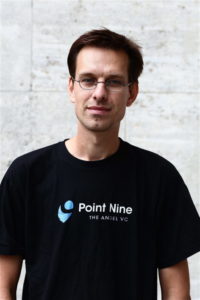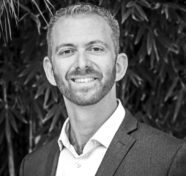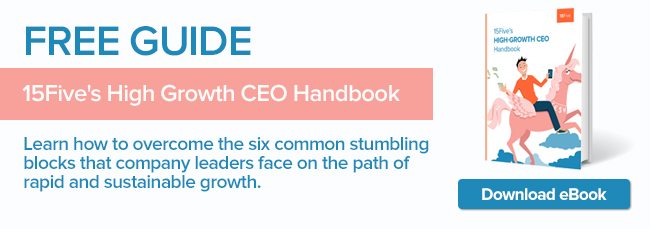What Every SaaS Startup Founder Should Know: A Conversation With Christoph Janz
Here at 15Five, we strive to bring you leadership advice on a variety of topics like employee engagement, communication, business growth, and company culture. We’re switching gears a bit to provide insights on what investors are looking for when it comes to startups and the teams that help them grow.
 I recently sat down with Christoph Janz, a Founding Partner of Point Nine Capital, an early-stage VC fund focused on SaaS and marketplaces. Christoph invested in more than 20 SaaS startups, including 15Five, Algolia, Automile, Contentful, Geckoboard, Procurify and Typeform, as well as Zendesk, where he was the first outside angel investor. A former entrepreneur himself, he has become a renowned SaaS expert and is the author of the popular blog The Angel VC.
I recently sat down with Christoph Janz, a Founding Partner of Point Nine Capital, an early-stage VC fund focused on SaaS and marketplaces. Christoph invested in more than 20 SaaS startups, including 15Five, Algolia, Automile, Contentful, Geckoboard, Procurify and Typeform, as well as Zendesk, where he was the first outside angel investor. A former entrepreneur himself, he has become a renowned SaaS expert and is the author of the popular blog The Angel VC.
Christoph discusses his criteria for investing and what attracted him to invest in 15Five. We also get into the future of SaaS and venture capital, and what strategies he uses to build culture and cohesion on the Point Nine team. Pay attention founders!
DM: You’ve had three exits, two as founder and one as investor at Zendesk. What are your criteria for investing? Is there a common theme or specifics like product/market fit, acquisition strategy, MRR growth…etc…?
CJ: We look for a couple of things that are quite usual, and you would get similar answers from other investors. Every investor looks for general qualities in a company and founding team – a great market, product and team.
Go a level deeper and many VCs have some areas that they are particularly focused on. For Point Nine, that’s SaaS and two-sided online marketplaces, where supply and demand are doing some type of transaction.
We do exclusively early stage investments, almost always at the seed stage and before Series A. Geographically we are pretty agnostic. We invest all over Europe and occasionally in the US and Canada.
We are definitely looking for product/market fit and have a strong bias for beautiful products. One of the things that I liked at Zendesk from day one was how great the product was and the consumerization of the entire experience. Many of the SaaS companies we invest in follow those themes.
DM: Why 15Five? We certainly have style, but we’re not European. Was it the team? The mission?
CJ: 15Five meets all of the criteria that I described. It’s a great and simple product, so I could quickly get into the shoes of a user and get a feel for what the product does (plus we are using it at Point Nine now). It makes it easier to assess a potential investment when you can test the product yourself.
One of the things that intrigued me initially (and continues to) is what 15Five stands for. The company is facilitating communication between managers and employees and between people at different organizational levels, in a simple tool which people enjoy using. Contrast that experience to old-school HR software and processes that people tend to hate.
DM: Certainly everything is profit-driven on some level, but you seem to see business as a vehicle for change. How does a company mission factor in for you as an investor?
CJ: The ultimate goal is to make money, especially because the money that we invest comes primarily from our investors, our so-called Limited Partners. But there doesn’t need to be a trade-off between profit and investing in companies that improve the world rather than make it worse.
One factor we look for is whether or not the founders really believe in what they’re doing. Creating a business is very hard and is inevitably accompanied by so many ups and downs. It’s never a smooth ride up and to the right. When it comes to the difficult times, a founding team that really wants to change the world or is not primarily driven by money is more likely to turn around the low points. They are in it for the long run.
If we were to invest in a startup where all of the managers were just driven by money, then a couple of bad quarters might be enough for them to give up. You need crazily committed people and the driver for that level of commitment usually comes from really believing in what they’re doing.
DM: In this Medium post, the Point Nine team shares their predictions for 2016. You said that Europe will grow in seed and series-A funding. Are you seeing any challenges to European VC funding, especially as a result of Brexit?
CJ: There are several developments or trends overlapping each other. It’s hard to determine the net impact. One of the biggest drivers is that there are many more funds in Europe than ever before, many have emerged only within the last couple of years. So European companies are in a better position to raise a seed or A-round than before. This is a bigger factor than some of the macro factors, like what we are seeing in the UK. In the end, because investors are in the business of investing, things may slow down for a couple of quarters, but will likely bounce back.
DM: In that same article you discuss how increased competition means more options for startups and VCs, who will have to work harder to prove value-add beyond the money. What did you mean by that?
CJ: As a VC, you have more competition so you will have to work harder. If you are raising money as a startup you are speaking to multiple investors. That’s always been the case in the US and is increasing in Europe. Founders are super-sharp people, so they consider who will make the best partners. They are looking for value-add beyond the money.
DM: Beyond the money, what’s a “right fit” between founder and investor?
CJ: For starters there needs to be a personal fit with chemistry present. This is going to be a long term relationship. You’re looking at ten years together if things go well. So founders should pick investors with whom they enjoy speaking. If you don’t like talking to the person before investing, that’s a serious red flag.
Look for someone whose feedback you appreciate and who has experience with similar companies and fields. That way they can bring expertise, knowledge and their network to the table. The way we try to achieve this is by specialization. As I said, we are focused on SaaS and marketplaces at a certain phase. If we were to be more diverse with our small team, we wouldn’t be able to develop deep enough knowledge in any one vertical.
Many of the challenges that founders face, especially within the first two years after we invest, are challenges we have seen before at other companies. We can then translate some of the learnings or connect people with other founders who have been in that exact situation already.
DM: Beyond leveraging the expertise between founders, is there anything else that you do to connect portfolio companies? For example, Unbounce (another Point Nine portfolio company) uses 15Five and vice versa.
CJ: We connect the founders and other key people at our portfolio companies. We have a Slack channel and a Honey site. Honey is an online collaboration tool that’s ideal for groups to work together online – sharing knowledge, posting articles and introducing their own products.
We also do offline events, like our larger annual SaaS event in Berlin or SF. We bring everyone together for two days for networking and knowledge sharing. Or we have smaller local meetups. Because in many situations, the peers are much better at helping each other than we could ever be. You see situations, where an early stage founder can learn from somebody further along who sees the same challenges all the time.
(I commented that it feels like a family, to which Christoph responded, “Yes! We even have the hashtag #P9Family.”)
DM: You foresaw the explosion in SaaS years ago. Has it met your expectations? What do you predict is next?
CJ: I didn’t have a clear expectation when I started with SaaS about 8 years ago. I didn’t have much knowledge then and just stumbled into this with my investment in Zendesk. Then I slowly learned more about it.
Eventually all software will be SaaS. I can’t imagine that future generations will have servers in their basements. In the last five to ten years or so, there has been a great deal of movement in this direction. The shift will continue to take time because of all the investment in old, on-premise software.
But whenever new decisions are made, the deployment preferences get turned completely upside down. 10 years ago something like eighty percent of enterprise software buyers preferred on-premise and now it’s more like 80/20 in favor of SaaS.
Also, ten years ago nobody predicted the whole mobile piece. There were no smartphones as we know them today at that time, so this adds a new dimension which augments the benefits of SaaS. With on-premise software it’s very hard to give people access on their phones!
DM: Do you think there will be a saturation point in SaaS? I feel “oversaasified” at times – using too many apps instead of a consolidated platform.
CJ: Statistically if you look at 1000 SaaS startups, the majority will not survive or become big. For every new technology, lots of companies start and then you have a consolidation into a smaller number of very large companies. That said, with SaaS you can build successful companies in very small niches. You can live a profitable life there with a very tailored product and focused message that is optimized and caters to a specific target group. If that group isn’t big enough to get the attention of the big guys, there may be some continued fragmentation.
On the other hand, you mentioned that you don’t want to use too many apps at the same time. I tend to think that you will not use fewer applications in the future, but they will all talk to each other. You will use the best in class solution for a number of use cases. The advantage of having the best quality product for any business problem more than offsets the advantage of having an all-in-one solution, as long as they can all work together via APIs.
DM: What’s your top advice for B2B Subscription SaaS companies looking to get seed funding?
CJ: In my SaaS Funding Napkin, I try to break down what you need to show as a startup for each round of funding. For any given metric, the range is very broad though – and a lot depends on the track record of the entrepreneurs. (Note: In the “napkin” piece, Christoph breaks down criteria like valuation, MRR, traction, defensibility…etc… for pre-seed rounds all the way to Series C. Check it out!)
For most startup founders without previous large exits and proven track records, the bar for a Series A is pretty high in terms of how much MRR and other growth metrics you need to have in place. Many of the companies that years ago would have been at the Series A stage, tend to raise a second seed round today. But interestingly, today that second seed round might be as big as that A round was several years ago.
For a typical seed round, we look for very strong signs of product/market fit. Sometimes we’ll invest at an even earlier stage but usually we want to see at least some indications for product/market fit.. This can come through a handful of happy customers or some early but encouraging growth metrics. We are always happy to take a look even if it’s too early, and then follow companies over time.
DM: At 15Five, we are all about asking questions to gain visibility, build culture, and coach employees when needed. From your experience at Point Nine and past companies, what questions do you ask your team, or what other strategies do you have?
CJ: This topic is so critically important that we hired a full-time Head of Talent, whose main job is helping our portfolio companies get better at hiring and building culture. She also helps us internally at Point Nine. We have a great culture in terms of how we work, respect each other, and resolve issues, but she helps our team even more than we thought she would. For example, we didn’t pay as much attention to things like career development. Now we have more focus on this.
If you are a growing startup planning on hiring about twenty people per year, you should have a full-time HR person sooner rather than later. Otherwise the CEO has to spend 100% of his or her time on hiring.
We also ask the standard questions that are suggested by 15Five out of the box:
– What’s going well? What are you proud of this week?
– What challenges are you facing? Where are you stuck?
And we came up with our own questions, for example:
– How does your workload look? Are you in control of things or totally overwhelmed?
This is always interesting to see because it quickly shows who needs help.
– Is there anything that you want to discuss with either Pawel (other co-founder) or Christoph?
Obviously people can reach out to us any time, but at least once every two weeks we ask this question and use the response as a starting point to follow-up. We are only ten people, but for bigger companies asking these questions via a feedback tool is even more important. Even for a small team like ours where people are often traveling, the tool can be very helpful.

David Mizne is Content Manager at 15Five, employee engagement and feedback software that helps create high performing teams by combining pulse surveys, weekly check-ins, peer recognition, and people analytics all in one platform. David interviews business leaders and entrepreneurs about management techniques and ideas that impact the modern workplace. Follow him on twitter @davidmizne.
Photo Courtesy of Bluefield College
Do you have a question or feedback for Christoph? Leave it in the comments below…





